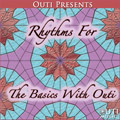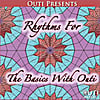

Rhythms CD For The Basics With Outi
|
This collection of rhythms is used in Outi's teaching DVD "The Basics With Outi". This CD is included in the DVD package, but it it also available by itself. Here is some additional information on the rhythms to help all the students to understand more of our beloved dance. In addition to the percussion istruments, all the tracks include one or two melodical one as well, helping the student to recognize their sound and enabling the use of the tracks in learning how to dance taksims - instrumental solos. |
The are two different accents in oriental dance done by tabla: DUM as a deeper, lower and stronger accent and TEK as a higher accent. The rolling is also very often used.
All the tabla players add their own flourishes and style. Here are the basic rhythm patterns so it will be easier to understand the basic pattern of the rhythm.
1. Masmoudi 8/4 with violin 3:19
Masmoudi (also called Masmoudi Kebir) is a very common Arabic rhythm. Kebir means big or large in Arabic. Masmoudi has two 4-beat parts, where the first part hast two dums. In one common variation the rhythm is started with three dums instead of only two. Masmoudi is often used in tandem with maqsoum, ie., in a song the slower parts are played with masmoudi and the faster with maqsoum.
Masmoudi is vocalized as "dum dum te-ke tek dum te-ke tek te-ke".

2. Maqsoum 4/4 with accordion 3:09
Maqsoum is everywhere. It's probably the most commonly used Arabic rhythm. You can find it in folk and pop music, entrance pieces and calssical songs. Maqsoum means divaded in Arabic. Maqsoum is often used in tandem with masmoudi, ie., in a song the slower parts are played with masmoudi and the faster with maqsoum.
Maqsoum is vocalized as "dum tek - tek dum tek".
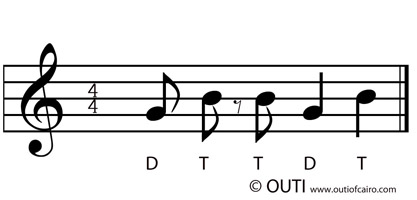
3. Wahda 4/4 with accordion & qanoon 3:08
Wahda is easy to recognize from the one dum at the beginning. The ending of the rhythm has as many variations as there are tabla players. Teks, rolls and other accents makes the rhythm very rich. Wahda means one or single in Arabic. Wahda can be used in many styles of music - in particular with vocals as the feeling is slow and unhurried. Wahda is also very good for transitions between rhythms.
Wahda is vocalized with the first "dum".
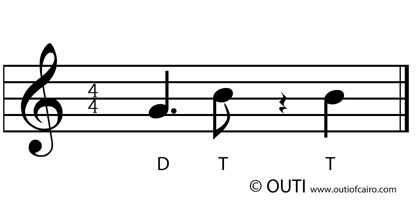
4. Sombati 4/4 with oud & nay 3:04
Sombati is one variation of a maqsoum with different accent.
Sombati is vocalized as "dum - tek tek dum tek". Pay attention to the rhythm of the first teks (and the pause) as sombati is so close to maqsoum.
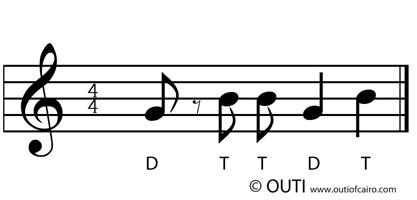
5. Conga 4/4 with qanoon 3:20
Conga is a great rhythm. The accent at the end can be kept silent or it can be filled differently - usually with rolling or other tek accents.
Conga is vocalized as "dum tek dum tek (pause)".
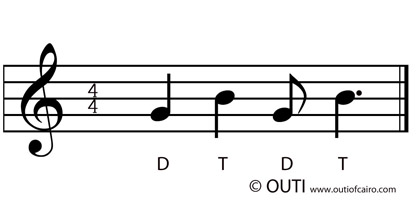
6. Samai 10/8 with violin 3:05
Samai is easy to recognize as even though you often hear only eight accents, you still count to ten as there is often a pause for two counts at the end of the rhythm pattern. It's often used with melody as the feeling of samai is very floating and relaxed. Samai is one of the most popular rhythms usen in Mawashahat.
Samai is vocalized as "dum -- tek - dum dum tek es es".

7. Malfuf 2/4 with sagat & keyboard 3:09
Malfuf is a very energetic rhythm. It's used widely in folk and pop music - especially the entrance and exit of the dancer are often played with malfuf. Malfuf means wrapped or spun around in Arabic and has a short and cyclical feeling in it.
Malfuf is vocalized as "dum tek tek".
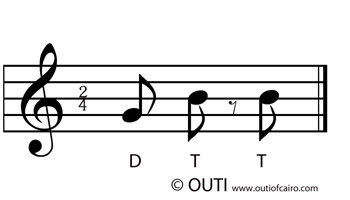
8. Ayoub 2/4 with sagat & nay 3:10
Ayoub can be spelled in many ways and it is also called zar. It is used in folk music and especially at a slower tempo it is associated with zar ritual (or trance dance) - hence the name. The first dum is a much stronger one compared to the other giving the rhythm very heavy feeling.
Ayoub is vocalized as "dum-ke dum tek".
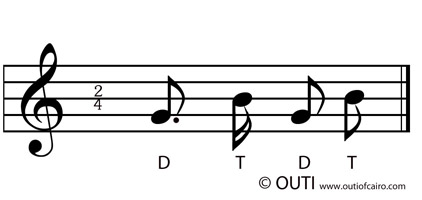
9. Fellahi 2/4 with accordion & qanoon 3:10
Fellahi is the same rhythm as maqsoum - only twice as fast. It is used in folk music. Fellah means peasant or farmer in Arabic. Fellahi is often used in tandem with saidi, ie., in a song the slower parts are played with saidi and the faster with fellahi.
Fellahi is vocalized as "dum te-ke dum tek".
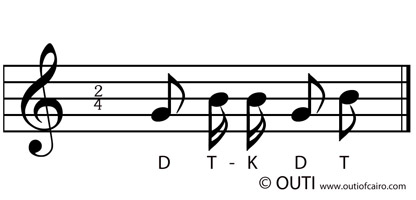
10. Saidi (slow) 4/4 3:13
11. Saidi (medium) 4/4 3:57
12. Saidi (fast) 4/4 3:10
Saidi comes form the Upper Egypt - Saidi area. It is easy to recognize as there are two strong dums in the middle of the rhythm, for example, in one variation the first dum might be completely omited. Saidi rhythm is used in saidi music - the songs from the Upper Egypt. Saidi is often used in tandem with fellahi, ie., in a song the slower parts are played with saidi and the faster with fellahi. Intrestingly, during the last few years pop music, especially shaabi music, has started to use the saidi rhythm instead of the more common maqsoum. In this case it is very important to know the song, lyrics and origin, so that the dancer can dance accordingly in the correct style.
Saidi is vocalized as "dum tek dum dum tek".
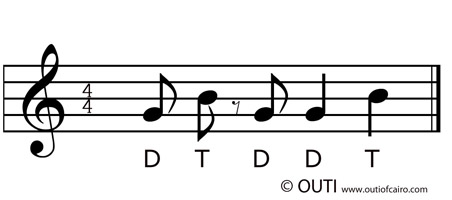
13. Akdeb 'alek 3:34
This Warda's classic is always a hit. This wonderful arrangements gives something for everyone. The beginner benefits from the shortness and simplicity of the song while at the same time there are exciting nuances for the professional dancer, and Arabs love it and will sing along.
Download online:
CD Credits:
Keyboard: Mohamed Ali
Accordion: Mohamed Hanafy
Nay: Mohamed Ali
Oud: Mohamed Salama
Violin: Hassan Mahmoud
Cello: Hisham Mostafa
Qanoon: Mahmoud Amer
Mizmar: Ateiya
Rababa: Said Shar
Tabla: Yahya Goman
Vocals: Noura
Arrangement: Mohamed Ali
Sound engineering: Mohamed Ali
Artistic director: Outi
Recorded in Nay Sound Studio, Giza, Egypt
If you like to use any of the music in your own production (CD, DVD, video), contact Outi. The prices are dancer friendly.
website design by
Michelle Joyce,
Website Delight
copyright © Outi 2007–2022 all rights reserved
